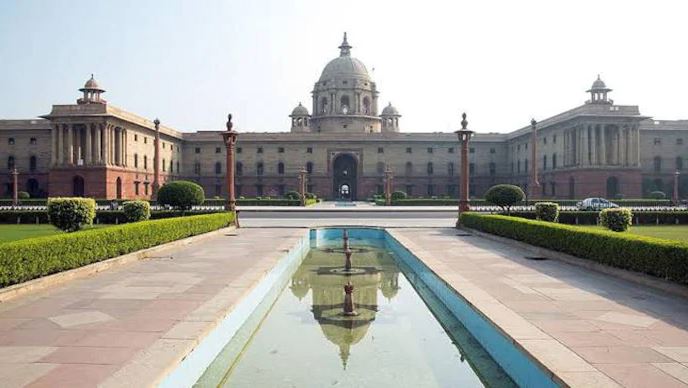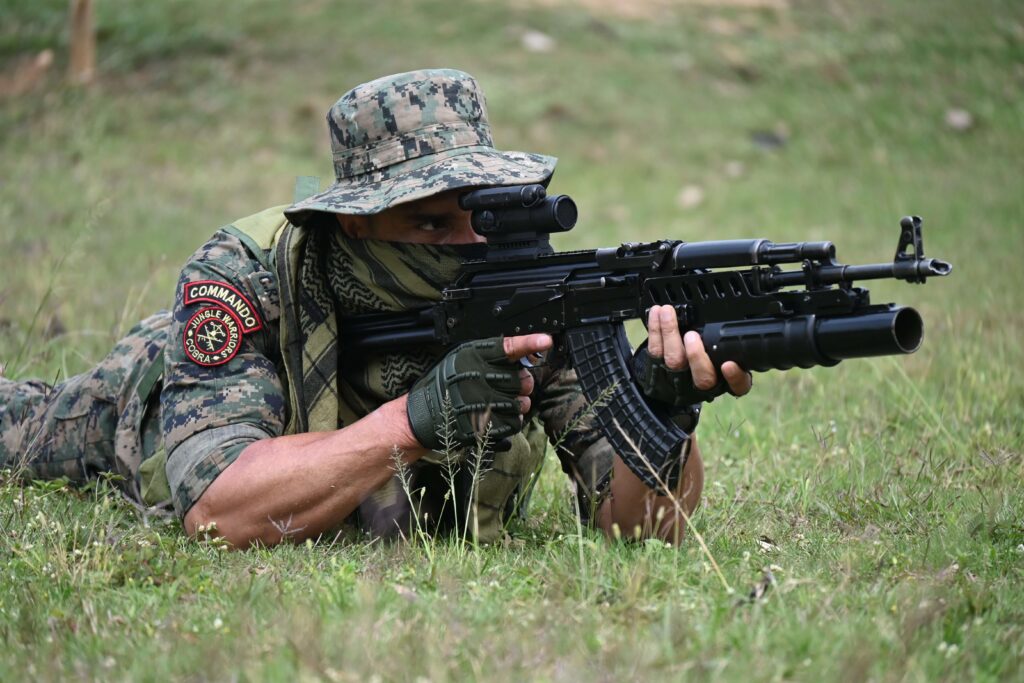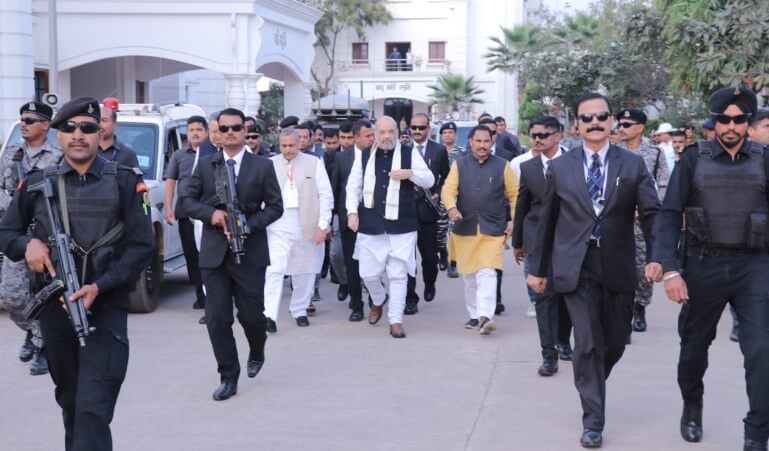

Supreme Court proposes, Ministry of Home Affairs (MHA) disposes…or so it seems…but in the process CAPF officers continue to suffer.
Recently, the Supreme Court in a landmark judgement on May 23, 2025, recommended cadre review in the Central Armed Police Forces (CAPFs), and progressive reduction in deputation of IPS officers—especially up to the rank of Inspector General (IG)—within two years.
However, even after the path-breaking judgment in Sanjay Prakash & Ors. Vs Union of India (May 2025), the Ministry of Home Affairs has inducted at least ten Indian Police Service (IPS) officers on deputation – usually for a period of five years – to different Central Armed Police Forces (CAPFs) in the last four months. This amounts to defeating the spirit behind the Supreme Court directive, which gave equal rights and opportunities to CAPF cadre officers to lead the organisation they have served all along their service life. The new appointments from the post of Commandant to Inspector General (IG) across various CAPFs posts include:
| S.No. | Name of IPS officer | Batch | Posted as | Organisation |
| 1 | Senthil Avoodai Krishna Raj S | UK: 2007 | Inspector General (IG) | CISF |
| 2 | Kabib K | MA: 2005 | Inspector General (IG) | CRPF |
| 3 | Nishit Kumar Ujjwal | MA:2001 | Inspector General (IG) | SSB |
| 4 | Malothu Ramulu Naik | BH: 1998 | Inspector General (IG) | SSB |
| 5 | Rudolf Alvares | MP:2009 | DIG | SSB |
| 6 | Babu Ram | BH:2009 | DIG | CISF |
| 7 | Swapnil Mamgain | UP: 2011 | DIG | BSF |
| 8 | Sanjay Kumar Sain | AGMUT11 | DIG | CISF |
| 9 | Shashvat Kumar | TR: 2016 | Commandant | SSB |
| 10 | Preeti Priyadarshini | UK:2012 | Commandant | ITBP |

The May 2025 Supreme Court’s landmark judgment recognised five CAPFs—CRPF, BSF, CISF, ITBP, and SSB—as “Organised Group A Services” (OGAS) and mandated structural reforms to address cadre stagnation and leadership inequity. These include:
- Carrying out cadre review in all the CAPFs within a period of six months.
- Reviewing the existing service rules/recruitment rules of each of the CAPFs.
- Reducing IPS reservations in senior posts (e.g. upto SAG (IG) levels)
- Promoting CAPF cadre officers to leadership roles based on merit and service.

Historically speaking, IPS officers on deputation have always occupied decisive policy making posts within the Central Armed Police Forces, namely the Border Security Force (BSF), Central Reserve Police Force (CRPF), Indo-Tibetan Border Police (ITBP), Central Industrial Security Force (CISF), and Sashastra Seema Bal (SSB). These posts, which should ideally have been occupied by deserving CAPF cadre officers, include:
- 20–25% of Deputy Inspector General (DIG) posts reserved for IPS officers.
- 50% Inspector General (IG) level posts manned by IPS officers.
- 75% of Additional Director General (ADG) level held by IPS officers. Promotion of CAPF cadre officers beyond IG has been rare, with only a handful have reached the ADG level in BSF, CRPF, CISF, ITBP, and SSB. Significantly though the Cadre Review Board (CRB) in 2016 had proposed increasing the ADG posts in CRPF to 11 at present, 3 out of 4 ADGs in CRPF are IPS officer and only one is a cadre officer.
- About 8 Special DGs (SDGs) – All SDG and above posts in CAPF are reserved exclusively for IPS. No CAPF cadre officer has ever been posted as Special DG or DG.
- 7 Director General (DG) – All DG level posts in CAPFs are occupied by IPS officers on deputation, and no CAPF cadre officers can expect to reach this position.
This is the root cause of the problem – and one of the main reasons behind the stagnation and bottleneck in the promotion of more than 12,000 CAPF cadre officers, many of whom spend decades in service without ascending to the top leadership roles.
IPS Promotion Timeline
| Rank | Years of Service (Approx.) |
| Assistant Superintendent of Police (ASP) / Assistant Commissioner of Police (ACP) | Entry Level (0–4 years) |
| Deputy Superintendent of Police (DSP) / Deputy Commissioner of Police (DCP) | 4–9 years |
| Superintendent of Police (SP) / Senior DCP | 9–12 years |
| Deputy Inspector General (DIG) | 12–16 years |
| Inspector General (IG) | 16–25 years |
| Additional Director General (ADG) | 25–30 years |
| Director General of Police (DGP) / Apex Scale | 30+ years |
The officer hierarchy within the CAPFs begins at the rank of Assistant Commandant, moving on to Deputy Commandant, Second-in-Command, Commandant, Deputy Inspector General (DIG), Inspector General (IG), Additional Director General (ADG), and Director General (DG). While exact numbers may fluctuate, the estimated sanctioned strength of CAPF officers across all ranks in Group-A is as follows:
| Rank | Approximate Sanctioned Strength (All CAPFs Combined) | Years of Gp-A Service Prescribed in RR for next promotion | Years of Gp-A Service actually required for promotion. |
| Assistant Commandant | ~9000 | 6 yrs | Entry Grade |
| Deputy Commandant | ~3,500 | 11 Yrs | >15 Years |
| Second-in-Command | ~2,000 | 16 Yrs | >20 Years |
| Commandant | ~1,200 | 21 Yrs | >25 Years |
| Deputy Inspector General (DIG) | ~600 | >29 Years | |
| Inspector General (IG) | ~250 | 24 Years | >32 Years |
| Additional DG | ~50 | 30 Years | >39 Years |
| Director General | 7 (One per CAPF) | — | – |
These figures do not include IPS officers on deputation, who occupy a significant number of senior level appointments—particularly at the IG and ADG levels.
Why are the IPS not suited to replace CAPF cadre officers?

While the IPS too have a similar rank structure, there are fundamental differences in training and operational ethos. The IPS officers are trained primarily for law and order management, criminal investigation, and district-level governance. The IPS officers—trained primarily in civil policing—often lack the tactical and strategic experience of paramilitary command. They have little or no knowledge or experience of jungle warfare in the CRPF, high-altitude patrolling in ITBP, or border surveillance in BSF. In contrast, CAPF officers develop skills in specialised tasks like border patrolling to check infiltration and smuggling, counter-insurgency, industrial protection and disaster management due to their deployment in some of the most inhospitable terrain over the years.
Also Read: CAPFs are Organized ‘Group A’ Services (OGAS): Supreme Court
Initially, IPS officers were posted in top leadership roles of the Central Armed Police Forces (CAPFs) because the cadre officers lacked the required experience that IPS officers brought by virtue of their training and experience in state police forces. The CAPFs, being primarily raised for operational duties, did not have a mature career progression system or institutional mechanisms to develop senior leadership from within. However, over the years, CAPF cadre officers have acquired extensive operational experience in insurgency-hit areas, border security, and internal security, along with specialized training in strategy, logistics, and command. This evolution has changed the dynamics, making the argument for exclusive IPS leadership less relevant and strengthening the case for promoting career CAPF officers to head their own forces.
The IPS officers on deputation – who may have never commanded a CAPF battalion or taken part in an active operation on the field and do not know the troops by name –their strengths and weaknesses, topography of the terrain, as well as the range or capability of all the weapon systems at their disposal – leave alone fired them in a real life situation- except maybe at the firing range. Still, the IPS officer literally para-drops from the top and starts giving orders from day one, which the CAPF cadre officers with much longer years of service and experience in the field have to follow. Just to give you an idea an IPS officer with 9–12 years of service assumes the rank of Superintendent of Police (SP) / Senior DCP or Deputy Inspector General (DIG) in 12–16 years – though most CAPF officers — retire even before they reach the Commandant level–after nearly 30 years of service.
Significantly the IPS officers who come on deputation at DIG and above level are mostly about to retire. Hence, instead of trying to learn new things about the concerned organisation, they spend their time developing contacts who might be useful when it comes to settling down with their family after retirement. This is one of the main reason why they pick and choose the CAPF organisation – not because of operational reasons or one that suits their skill, or aptitude, but the one which at least has a battalion near their home town.
Historical Evolution of CAPF Organisations

The origins of CAPFs can be traced back to the British colonial era, when paramilitary formations were raised to enforce imperial authority in volatile frontier regions. The need for a centralised force to assist states in maintaining law and order led to the formal constitution of the Central Reserve Police Force (CRPF) as the Crown Representative Police in 1939, which became the first organised paramilitary force of independent India. After long debate in Parliament, on strong recommendation by Sardar Patel about its future role to keep India united, this force was rechristened as Central Reserve Police Force by an Act of Parliament on 28th December, 1949. Subsequent decades saw the creation of specialised forces:
- Indo-Tibetan Border Police (ITBP) was established in 1962, post the Sino-Indian conflict, to secure the Himalayan frontier.
- Sashastra Seema Bal (SSB) was established in 1963, originally as the Special Service Bureau, to promote national integration in border areas.
- Border Security Force (BSF) was established to guard international borders in 1965, following the Indo-Pak war.
- The Central Industrial Security Force (CISF) was established in 1969 to protect critical infrastructure and industrial undertakings.
- National Security Guard (NSG) was established in 1984, as a specialised counter-terrorism and hostage rescue force, following Operation Blue Star. It’s 100% deputationist force, with 53% personnel from Army and the remaining 47% from CAPFs.
These forces were initially referred to as Central Para-Military Forces (CPMFs), but in 2011, the Government of India adopted the nomenclature “Central Armed Police Forces” to better reflect their role and to align with international terminology.
The Long Road to OGAS Recognition
CAPFs are administratively under the Ministry of Home Affairs (MHA), but their leadership structure has long been a point of contention. Each force has its own cadre of officers, recruited through the UPSC CAPF examination, yet the apex leadership positions—Director General (DG), Inspector General (IG), and Deputy Inspector General (DIG)—have traditionally been reserved for officers of the Indian Police Service (IPS).
The CAPF officers have been demanding parity with other Group A services like the IAS and IPS. Over 60 other services in India, including the Indian Forest Service, Indian Revenue Service, and Indian Audit and Accounts Service, enjoy OGAS status. Even specialised services like the Indian Ordnance Factories Service have long enjoyed OGAS status. Hence, the exclusion of CAPF officers from this list is meaningless, unreasonable and unjust.
Can you imagine the effect of this on the morale of the regular CAPF cadre officers who are considered unfit to lead their respective organisation?
Psychological impact on the morale of CAPF cadre officers

Promotion backlog is one of the main causes of this crisis. According to the government of India statistics, nearly 55,000 personnel across CAPFs opted for voluntary retirement or resignation between 2020 and 2024. About 4,127 Border Security Force personnel took voluntary retirements, 2,572 in CRPF, 596 in CISF, 324 in ITBP and 271 in SSB in 2023 alone. This is an indication of the growing discontent, disillusionment and demotivation in the rank and file.
To make matters worse, stagnation is literally a matter of life and death, which led to around 654 suicides between 2018 and 2022, reflecting persistent stress and hopelessness among the CAPF personnel– an average of one every three days. The CRPF accounted for the maximum 230 suicide cases, followed by the BSF with 174 during this period.
The solution:

The solution is clear but requires political will.
The Indian Forest Service (IFS) officers enjoy OGAS recognition and Non-Functional Financial Upgradation (NFFU) in line with their IAS batch counterparts. Its officers rise through the ranks based on service and merit, not external deputation.
Similarly, the Indian Revenue Service (IRS) and Indian Audit & Accounts Service (IA&AS) succeeded in securing OGAS status after sustained representation to the government for parity with other central services. Their demands included improved pay scales, timely cadre reviews, and enhanced promotional avenues, as well as recognition of their role in revenue collection and audit functions.
CAPF officers, on the other hand, continue to report to IPS officers with little operational experience in issues relating to paramilitary forces. All that is required is to reduce IPS deputations in a time-bound manner; conduct cadre reviews at regular intervals; and, most importantly, implement a transparent and merit-based promotion policy that values the experience and ground service put in by the regular cadre officers.
India cannot afford to let its front-line security forces — who guard the nation lose hope in their own future and feel undervalued, demoralised and trapped. The cadre review suggested by the Supreme Court should not end up as another futile exercise.
India may look to models such as the U.S. Border Patrol, France’s Gendarmerie, and other federal law enforcement agencies, which draw leadership from within their own ranks, ensuring operational continuity and institutional loyalty. In France, the Gendarmerie Nationale—though technically a military force—has a structured career progression system that rewards field experience and internal merit. Even in Brazil and Indonesia, paramilitary forces maintain distinct leadership pipelines, separate from civil police services.
These models underscore a fundamental principle: leadership in specialised forces must emerge organically from within. Deputations may serve a transitional purpose, but they cannot substitute for institutional expertise. India’s CAPFs, given their size, complexity, and strategic importance, deserve a leadership structure that reflects their unique operational mandate.
Toward a New Architecture of Internal Security

The recognition of CAPFs as OGAS opens the door to a comprehensive restructuring of paramilitary leadership, grounded in merit, professionalism, and institutional autonomy. To realise this vision, the following steps are imperative:
- Cadre Review and Expansion: The government must conduct a thorough cadre review to assess the sanctioned strength at each rank and create promotional avenues that reflect operational needs.
- Reduction of IPS Deputations: In line with the Supreme Court’s directive, IPS deputations must be progressively reduced, especially at the DIG and IG levels, and eventually phased out at the ADG level.
- Institutional Training and Leadership Development: CAPFs must invest in advanced training modules, leadership academies, and strategic planning units to groom officers for senior command roles.
- Policy Reform and Legislative Backing: The recognition of OGAS status must be codified through legislative amendments to recruitment rules, service regulations, and pay structures.
- Public Accountability and Transparency: The Ministry of Home Affairs must publish annual reports on cadre management, deputation statistics, and promotion timelines to ensure transparency and public accountability.
Conclusion: Restoring Dignity, Ensuring Effectiveness

The CAPFs are not make-shift forces. From guarding the borders to counterinsurgency or protecting VVIPs and critical infrastructure, they operate in some of the most volatile theatres of conflict and form the backbone of India’s internal security apparatus. Their officers operate in high-risk environments, make life-and-death decisions, and uphold the constitutional mandate of internal peace and territorial integrity. The Supreme Court’s recognition of CAPF officers as OGAS affirms the principle that leadership must be earned and that merit must triumph over privilege.
Recognising CAPF cadre officers as the custodians of their institutions is a moral imperative and a strategic necessity. India must ensure that its paramilitary forces are led by those who know them best: their own officers. The CAPF cadre officers must lead themselves.


Justice for CAPF. Pathetic condition prevailing in CAPF for GD cadre officers. Other cadre like Vetenary and medical are getting time bar promotion and becoming senior to GD cadre officers but No one taking care of this shameful condition for GD officers. Hopefully Judiciary and media may support CAPF in this struggling phase..
A very well researched and factually correct writeup.
Very explicitly discripted the issue faced by the CAPF cadre officers. The article very clearly mentions the pain of following the utter and inexperienced orders given by the immature/inexperienced Indian Police Services officers. This problem becomes highly exhausting in AOR with high responsibility and demand/execution of CAPFs, such as, Manipur and Nagaland sector (CRPF), J&K, etc.